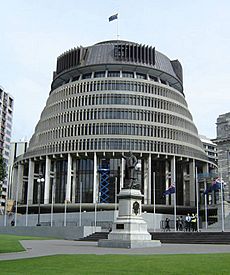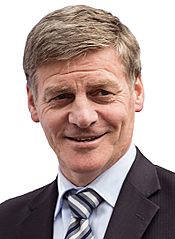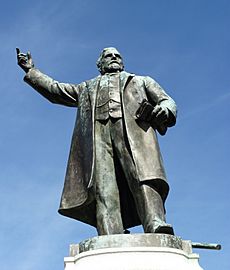Politics of New Zealand facts for kids
New Zealand has a special way of running its country. It's called a parliamentary democracy. This means people vote for leaders who represent them in Parliament. New Zealand is also a constitutional monarchy. This means it has a Queen, Elizabeth II, who is the head of state. But her power is limited by laws.
In New Zealand, the saying is: "The Queen reigns, but the government rules." This means the Queen is the head of state, but the elected government makes the decisions. The Prime Minister is the top government leader. They lead the Cabinet and are the head of government. The Prime Minister is chosen by the Governor-General of New Zealand. This job is the most powerful in New Zealand politics. Government ministers are chosen from the people elected to Parliament.
New Zealand has many political parties. Its rules for making laws come from the British Parliament. But New Zealand has made its own changes. Sometimes, a government doesn't have a clear majority. It then needs support from other parties to govern. The two main political parties in New Zealand have usually been the New Zealand Labour Party and the New Zealand National Party.
Contents
How New Zealand's Government Works
New Zealand does not have one single written document called a "constitution." Instead, its rules for government come from many places. These include laws from both the United Kingdom and New Zealand Parliaments. They also include the Treaty of Waitangi and special political traditions. The Constitution Act of 1986 brought many of these rules together.
People's rights are protected by common law. They are also strengthened by the Bill of Rights Act 1990 and the Human Rights Act 1993. However, Parliament can change these laws with a simple vote. The Constitution Act describes the three main parts of New Zealand's government:
- The Executive: This is the Queen and the Cabinet. They carry out the laws.
- The Legislature: This is Parliament. They make the laws.
- The Judiciary: This is the court system. They interpret the laws.
Who Leads the Country?

| Office | Name | Party | Since |
|---|---|---|---|
| Queen | Elizabeth II | 6 February 1952 | |
| Governor-General | Patsy Reddy | 28 September 2016 | |
| Prime Minister | Bill English | National Party | 12 December 2016 |
The Head of State: The Queen

Elizabeth II is the current Queen of New Zealand. She is the country's head of state. The Queen of New Zealand is separate from the British Queen. This has been true since 1947. All her official work in New Zealand is done as the Queen of New Zealand.
The Queen does not usually live in New Zealand. So, her duties are carried out by the Governor-General. The Queen appoints the Governor-General based on the Prime Minister's advice. As of September 2016, the Governor-General was Dame Patsy Reddy.
The Governor-General's powers are mostly symbolic. They formally appoint and dismiss Prime Ministers. They can also dissolve Parliament. They sign laws after Parliament passes them. The Governor-General leads the Executive Council. This group includes all government ministers. New Zealand is a constitutional monarchy. This means the Queen and Governor-General follow the government's advice. They play a formal role in running the country.
The Head of Government: The Prime Minister

The Cabinet is the main group that makes government policies. It is led by the Prime Minister. The Prime Minister is usually the leader of the party that wins the election. They are known as the head of government. The Prime Minister is the real leader of New Zealand. They use powers that officially belong to the Queen.
The Cabinet is directly responsible to the New Zealand Parliament. All Cabinet ministers must be members of Parliament (MPs). They work together and are responsible to Parliament.
General elections happen every three years. The last one mentioned was in September 2014. The National Party won in 2008. This ended nine years of Labour-led government. Former National leader John Key formed a government. He worked with the ACT party, United Future, and the Māori Party. The leaders of these parties held minister jobs but were not in the main Cabinet.
At that time, there were three parties in opposition. These were the Labour Party, the Green Party, and New Zealand First. The leader of the opposition was Andrew Little. He was the leader of the Labour Party.
How Elections Work and Political Parties
New Zealand's first political party started in 1891. Its main rival began in 1909. For a long time, New Zealand mostly had two main parties. But in 1996, the voting system changed. Now, New Zealand has many political parties. As of 2014, eight parties were in Parliament. No single party has won enough votes to govern alone since 1996. This means coalition governments are now common.
The two largest and oldest parties are the Labour Party. They are centre-left and were formed in 1916. The other is the National Party. They are centre-right and were formed in 1936.
Other parties in Parliament as of 2016 included:
- ACT: A right-wing party that supports free markets.
- Greens: A left-wing party focused on the environment.
- New Zealand First Party: A centrist, nationalist party.
- United Future: A centrist party that supports family values.
- Māori Party: A party focused on ethnic Māori issues.
A Look at New Zealand's Political Past
Early Politics in New Zealand
Before New Zealand became a British colony in 1840, Māori chiefs led their communities. They used Māori customs as their political system.
After the Treaty of Waitangi in 1840, a British Governor was in charge. He tried to bring in the British political system. This worked better in some Māori communities than others. Māori who lived in more isolated areas were not much affected by the new government.
The first voting rights in New Zealand were created in 1852. This was for the 1853 elections. At first, only people who owned property could vote. But by the late 1850s, most British men over 21 could vote. About 100 Māori chiefs voted in the 1853 election.
In the 1850s, government was based in different provinces. This system ended in 1876. Early politics was mainly controlled by rich "wool lords" who owned many sheep farms. During the gold rush starting in 1858, more people could vote. This included British gold miners who had a mining license. Many gold miners came from Australia and brought new ideas.
After a short period of land wars ending in 1864, Parliament gave more Māori the right to vote. In 1867, Donald McLean introduced a law for four temporary Māori electorates. All Māori men over 21 could vote. This meant Māori men could vote 12 years before European men.
In the 1870s, Julius Vogel, a former gold miner, started a big plan. He borrowed a lot of money to improve the country's roads, railways, and ports.
An economic depression hit in 1879. Many people became poor. Between 1879 and 1881, the government was worried about Māori activists at Parihaka. These activists destroyed fences and ploughed up land that had been taken from them. They were arrested, but their actions continued. The government offered them a large reserve of land if they stopped. In 1881, the government arrested the leaders of the protest. This was a conflict over who had authority.
In 1882, New Zealand started exporting meat in refrigerated ships. This led to a time of strong economic growth. During this time, new ideas like the Fabians became popular. In 1890, the first political party, the Liberals, was formed. Their leader, Richard Seddon, was Premier from 1893 to 1906. The Liberals brought in new taxes for wealthy landowners. They also bought more land from Māori. By 1896, Māori owned 15% of the land. Many small farms were created during this time.

Women's Role in Politics
Women gained the right to vote after about 20 years of campaigning. Women like Kate Sheppard and Mary Ann Müller worked hard for this. Groups like the Women's Christian Temperance Union also helped. On September 19, 1893, the Governor, Lord Glasgow, signed a new law. New Zealand became the first self-governing country where all women could vote in national elections. Women first voted in the 1893 election. A high 85% of women voted, compared to 70% of men.
Women could not be elected to Parliament until 1919. Three women, including Ellen Melville, ran for election that year. The first woman to win an election was Elizabeth McCombs in 1933. She won the seat her late husband had held. Mabel Howard became the first female Cabinet minister in 1947.
New Zealand was the first country where all the top government jobs were held by women. This happened between March 2005 and August 2006. These roles included Queen Elizabeth II, Governor-General Dame Silvia Cartwright, Prime Minister Helen Clark, Speaker of the House Margaret Wilson, and Chief Justice Dame Sian Elias.
Recent Political Changes
The National Party (right-leaning) and the Labour Party (left-leaning) have been the main parties in New Zealand politics since 1935. A Labour government came to power in 1935. For 14 years (1935–1949), the Labour Party introduced many social and economic laws. These included social security, large public works, a 40-hour work week, and a minimum wage.
The National Party won power in 1949. They kept many of the welfare programs Labour had started. Except for two short Labour governments (1957-1960 and 1972–1975), National held power until 1984.
In 1984, the Labour government returned to power. They made big changes to the economy. They also passed anti-nuclear laws. This led to New Zealand being suspended from the ANZUS security alliance with the United States and Australia. They also made other left-wing changes. For example, they allowed the Waitangi Tribunal to hear claims about breaches of the Treaty of Waitangi back to 1840.
In October 1990, the National Party formed a government again. They held power for three terms. In 1996, New Zealand started using a new voting system. It's called Mixed Member Proportional (MMP). This system was meant to help smaller parties get into Parliament. It seems to have worked. Since 1996, neither National nor Labour has had a clear majority in Parliament. Most of the time, a minority government has been in charge. In 1995, Georgina Beyer became the world's first openly transsexual mayor. In 1999, she became the world's first openly transsexual Member of Parliament.
After nine years, the National Party lost the November 1999 election. Labour, led by Helen Clark, won more votes than National. They formed a coalition government with the left-wing Alliance. This government often needed support from the Green Party to pass laws.
The Labour Party stayed in power after the 2002 election. They formed a coalition with Jim Anderton's new party, the Progressive Coalition. They also had an agreement for support from the United Future party. Helen Clark remained Prime Minister.
After the 2005 general election, Helen Clark announced a third term for the Labour-led government. Labour again formed a coalition with Jim Anderton's Progressive Party. They also had support from Winston Peters' New Zealand First and Peter Dunne's United Future. Jim Anderton kept his Cabinet job. Winston Peters became Minister of Foreign Affairs. Peter Dunne became Minister of Revenue. Neither Peters nor Dunne were in the main Cabinet.
After the general election in November 2008, the National Party quickly formed a government. They worked with the ACT Party, the Maori Party, and United Future. This allowed National to rely less on the ACT party. In 2008, John Key became Prime Minister. Bill English was his deputy. On December 12, 2016, Bill English was elected Prime Minister. This happened after John Key unexpectedly resigned. Paula Bennett was elected Deputy Prime Minister.
Images for kids
-
Parliament House is the home of the House of Representatives
-
Former New Zealand Prime Minister Helen Clark worked for the United Nations Development Programme from 2009 to 2017.
See also
 In Spanish: Política de Nueva Zelanda para niños
In Spanish: Política de Nueva Zelanda para niños




